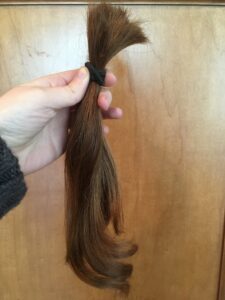Donating My Hair
Wigs have been around for a long time. Their earliest uses were to protect the heads of ancient Egyptians from extreme heat, and to help ancient Egyptians, Assyrians, Greeks, Phoenicians, and Romans celebrate important events. They were also used by aristocratic men in the United Kingdom and Europe in the 16th century. Many married Orthodox Jewish women have been wearing wigs since the 1600s. Today, people wear wigs for many reasons – to try a new, temporary hairstyle; to protect their natural hair from damage; or to combat hair loss from alopecia, burns, chemotherapy for cancer, or other health conditions.
Throughout history, wigs have been made of human hair, but other materials too, like palm leaf fiber and wool. Today, wigs are made mostly of human hair or synthetic hair. It costs a lot of time and money to make a single wig and takes a lot of hair; luckily, it’s easier than it seems to donate hair.
I don’t think I knew anyone growing up who donated their hair, but I remember hearing about Locks of Love and thinking it would be really cool to do that one day – and now I have! I’ve donated my hair three times to help make wigs for medical patients. To me, it’s an easy way to help people in need. I’m registered as an organ donor, I’ve donated blood a few times when I’ve been able to, and I need to cut my hair at least once a year anyway, so why not do something worthwhile with that, too?
I did a lot of research on organizations the first time I was ready to donate my hair. I wanted to make sure that I was donating to a reputable place that would not charge recipients for their wigs. I finally was able to donate 10 inches of hair to Pantene Beautiful Lengths in 2017, and another eight inches in 2018. They stopped taking donations in 2018, and between my wedding (which got postponed and shifted multiple times due to the COVID-19 pandemic) and being a bridesmaid in multiple friends’ weddings, I also took a pause on donating. The waiting paid off, though – in January 2023 I donated 12 inches to Children With Hair Loss! My goal for my fourth hair donation is at least 14 inches.

It’s free to donate your hair, but since wigs are so expensive to make, most organizations will accept monetary donations with or instead of hair. Although you can do the big chop yourself, I prefer to leave this to professional hairstylists so they can shape my hair properly after the donation amount comes off. Some organizations partner with local hair salons, and others are particular about how the donation should be cut (one organization I had considered asks for hair to be split into four sections, so you end up sending four ponytails instead of one), but you can also go to any salon – just let them know you’re doing a donation first, and make sure they cut your hair for the donation when it’s dry. Most, if not all, organizations will not accept wet hair (and it could get moldy or warped if you mail wet hair)!
Once you have your ponytail(s), if you didn’t go to a partner salon that will mail your hair for you, you usually need to mail the hair in yourself. Every organization has different mailing requirements – some want the hair in a bubble mailer, some want it in a plastic bag in a bubble mailer – but all require that the hair is clean and dry before mailing.

Hair Donation Organizations
If you are ready to make the cut, make sure to check the website of the organization you’ve chosen in case their requirements change!
- Chai Lifeline: At least 14 inches
- Children With Hair Loss: At least 8 inches; 12 or more is preferred
- Hair We Share: At least 12 inches, but they can accept at least 8 inches if you join their “ponytail tracking program” (this requires a donation of $145)
- Locks of Love: At least 10 inches
- Maggie’s Wigs4Kids of Michigan: At least 10 inches, but they will take at least 7 inches for shorter wigs
- Wigs for Kids: At least 12 inches; 14 or more is preferred
Other Sources
- nationaltoday.com/international-wig-day
- myjewishlearning.com/article/hair-coverings-for-married-women/
- womenshealthmag.com/beauty/a19981637/wigs/
- apnews.com/article/lifestyle-beauty-and-fashion-hair-care-personal-care-0fcb7a9fe480a73594c90b85e67c25d2
- insider.com/how-wigs-are-made-from-donated-hair-2020-4
- businessinsider.com/donating-hair-to-charity-what-you-need-to-know-2016-1